Gerard de Melo
Shammie
Pretrained LLMs Learn Multiple Types of Uncertainty
May 27, 2025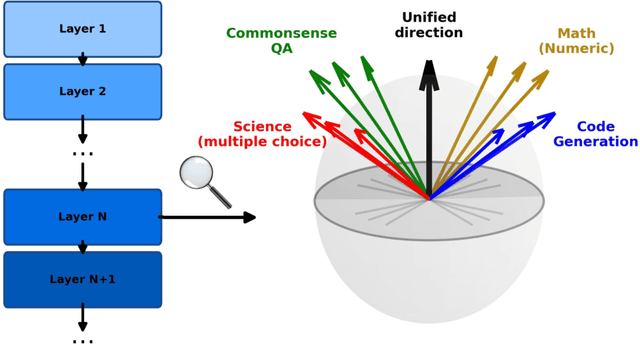

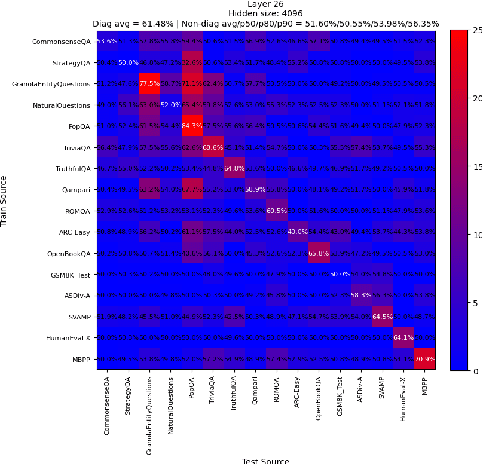
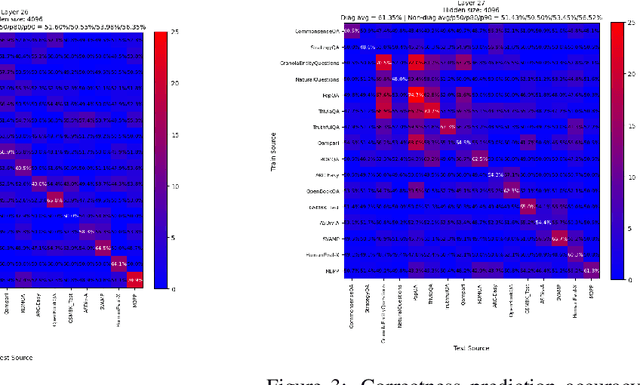
Abstract:Large Language Models are known to capture real-world knowledge, allowing them to excel in many downstream tasks. Despite recent advances, these models are still prone to what are commonly known as hallucinations, causing them to emit unwanted and factually incorrect text. In this work, we study how well LLMs capture uncertainty, without explicitly being trained for that. We show that, if considering uncertainty as a linear concept in the model's latent space, it might indeed be captured, even after only pretraining. We further show that, though unintuitive, LLMs appear to capture several different types of uncertainty, each of which can be useful to predict the correctness for a specific task or benchmark. Furthermore, we provide in-depth results such as demonstrating a correlation between our correction prediction and the model's ability to abstain from misinformation using words, and the lack of impact of model scaling for capturing uncertainty. Finally, we claim that unifying the uncertainty types as a single one using instruction-tuning or [IDK]-token tuning is helpful for the model in terms of correctness prediction.
InFact: Informativeness Alignment for Improved LLM Factuality
May 26, 2025Abstract:Factual completeness is a general term that captures how detailed and informative a factually correct text is. For instance, the factual sentence ``Barack Obama was born in the United States'' is factually correct, though less informative than the factual sentence ``Barack Obama was born in Honolulu, Hawaii, United States''. Despite the known fact that LLMs tend to hallucinate and generate factually incorrect text, they might also tend to choose to generate factual text that is indeed factually correct and yet less informative than other, more informative choices. In this work, we tackle this problem by proposing an informativeness alignment mechanism. This mechanism takes advantage of recent factual benchmarks to propose an informativeness alignment objective. This objective prioritizes answers that are both correct and informative. A key finding of our work is that when training a model to maximize this objective or optimize its preference, we can improve not just informativeness but also factuality.
AweDist: Attention-aware Embedding Distillation for New Input Token Embeddings
May 26, 2025Abstract:Current language models rely on static vocabularies determined at pretraining time, which can lead to decreased performance and increased computational cost for domains underrepresented in the original vocabulary. New tokens can be added to solve this problem, when coupled with a good initialization for their new embeddings. However, existing embedding initialization methods either require expensive further training or pretraining of additional modules. In this paper, we propose AweDist and show that by distilling representations obtained using the original tokenization, we can quickly learn high-quality input embeddings for new tokens. Experimental results with a wide range of open-weight models show that AweDist is able to outperform even strong baselines.
Image Tokens Matter: Mitigating Hallucination in Discrete Tokenizer-based Large Vision-Language Models via Latent Editing
May 24, 2025Abstract:Large Vision-Language Models (LVLMs) with discrete image tokenizers unify multimodal representations by encoding visual inputs into a finite set of tokens. Despite their effectiveness, we find that these models still hallucinate non-existent objects. We hypothesize that this may be due to visual priors induced during training: When certain image tokens frequently co-occur in the same spatial regions and represent shared objects, they become strongly associated with the verbalizations of those objects. As a result, the model may hallucinate by evoking visually absent tokens that often co-occur with present ones. To test this assumption, we construct a co-occurrence graph of image tokens using a segmentation dataset and employ a Graph Neural Network (GNN) with contrastive learning followed by a clustering method to group tokens that frequently co-occur in similar visual contexts. We find that hallucinations predominantly correspond to clusters whose tokens dominate the input, and more specifically, that the visually absent tokens in those clusters show much higher correlation with hallucinated objects compared to tokens present in the image. Based on this observation, we propose a hallucination mitigation method that suppresses the influence of visually absent tokens by modifying latent image embeddings during generation. Experiments show our method reduces hallucinations while preserving expressivity. Code is available at https://github.com/weixingW/CGC-VTD/tree/main
Hierarchical Safety Realignment: Lightweight Restoration of Safety in Pruned Large Vision-Language Models
May 22, 2025Abstract:With the increasing size of Large Vision-Language Models (LVLMs), network pruning techniques aimed at compressing models for deployment in resource-constrained environments have garnered significant attention. However, we observe that pruning often leads to a degradation in safety performance. To address this issue, we present a novel and lightweight approach, termed Hierarchical Safety Realignment (HSR). HSR operates by first quantifying the contribution of each attention head to safety, identifying the most critical ones, and then selectively restoring neurons directly within these attention heads that play a pivotal role in maintaining safety. This process hierarchically realigns the safety of pruned LVLMs, progressing from the attention head level to the neuron level. We validate HSR across various models and pruning strategies, consistently achieving notable improvements in safety performance. To our knowledge, this is the first work explicitly focused on restoring safety in LVLMs post-pruning.
AutoMedEval: Harnessing Language Models for Automatic Medical Capability Evaluation
May 17, 2025Abstract:With the proliferation of large language models (LLMs) in the medical domain, there is increasing demand for improved evaluation techniques to assess their capabilities. However, traditional metrics like F1 and ROUGE, which rely on token overlaps to measure quality, significantly overlook the importance of medical terminology. While human evaluation tends to be more reliable, it can be very costly and may as well suffer from inaccuracies due to limits in human expertise and motivation. Although there are some evaluation methods based on LLMs, their usability in the medical field is limited due to their proprietary nature or lack of expertise. To tackle these challenges, we present AutoMedEval, an open-sourced automatic evaluation model with 13B parameters specifically engineered to measure the question-answering proficiency of medical LLMs. The overarching objective of AutoMedEval is to assess the quality of responses produced by diverse models, aspiring to significantly reduce the dependence on human evaluation. Specifically, we propose a hierarchical training method involving curriculum instruction tuning and an iterative knowledge introspection mechanism, enabling AutoMedEval to acquire professional medical assessment capabilities with limited instructional data. Human evaluations indicate that AutoMedEval surpasses other baselines in terms of correlation with human judgments.
Hierarchical Divide-and-Conquer for Fine-Grained Alignment in LLM-Based Medical Evaluation
Jan 12, 2025Abstract:In the rapidly evolving landscape of large language models (LLMs) for medical applications, ensuring the reliability and accuracy of these models in clinical settings is paramount. Existing benchmarks often focus on fixed-format tasks like multiple-choice QA, which fail to capture the complexity of real-world clinical diagnostics. Moreover, traditional evaluation metrics and LLM-based evaluators struggle with misalignment, often providing oversimplified assessments that do not adequately reflect human judgment. To address these challenges, we introduce HDCEval, a Hierarchical Divide-and-Conquer Evaluation framework tailored for fine-grained alignment in medical evaluation. HDCEval is built on a set of fine-grained medical evaluation guidelines developed in collaboration with professional doctors, encompassing Patient Question Relevance, Medical Knowledge Correctness, and Expression. The framework decomposes complex evaluation tasks into specialized subtasks, each evaluated by expert models trained through Attribute-Driven Token Optimization (ADTO) on a meticulously curated preference dataset. This hierarchical approach ensures that each aspect of the evaluation is handled with expert precision, leading to a significant improvement in alignment with human evaluators.
NLSR: Neuron-Level Safety Realignment of Large Language Models Against Harmful Fine-Tuning
Dec 17, 2024Abstract:The emergence of finetuning-as-a-service has revealed a new vulnerability in large language models (LLMs). A mere handful of malicious data uploaded by users can subtly manipulate the finetuning process, resulting in an alignment-broken model. Existing methods to counteract fine-tuning attacks typically require substantial computational resources. Even with parameter-efficient techniques like LoRA, gradient updates remain essential. To address these challenges, we propose \textbf{N}euron-\textbf{L}evel \textbf{S}afety \textbf{R}ealignment (\textbf{NLSR}), a training-free framework that restores the safety of LLMs based on the similarity difference of safety-critical neurons before and after fine-tuning. The core of our framework is first to construct a safety reference model from an initially aligned model to amplify safety-related features in neurons. We then utilize this reference model to identify safety-critical neurons, which we prepare as patches. Finally, we selectively restore only those neurons that exhibit significant similarity differences by transplanting these prepared patches, thereby minimally altering the fine-tuned model. Extensive experiments demonstrate significant safety enhancements in fine-tuned models across multiple downstream tasks, while greatly maintaining task-level accuracy. Our findings suggest regions of some safety-critical neurons show noticeable differences after fine-tuning, which can be effectively corrected by transplanting neurons from the reference model without requiring additional training. The code will be available at \url{https://github.com/xinykou/NLSR}
ACE-$M^3$: Automatic Capability Evaluator for Multimodal Medical Models
Dec 16, 2024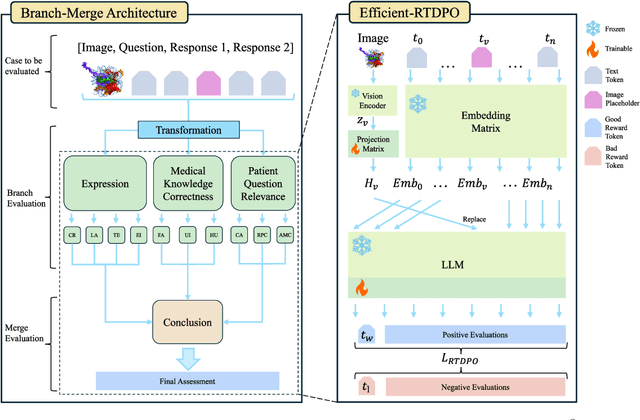

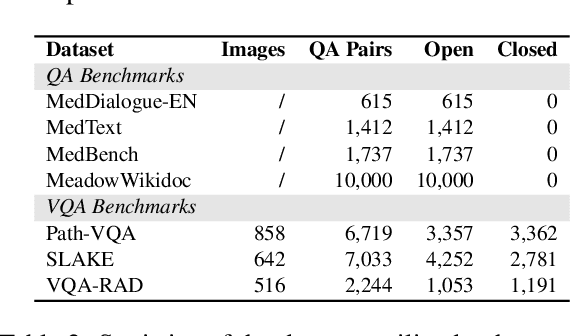
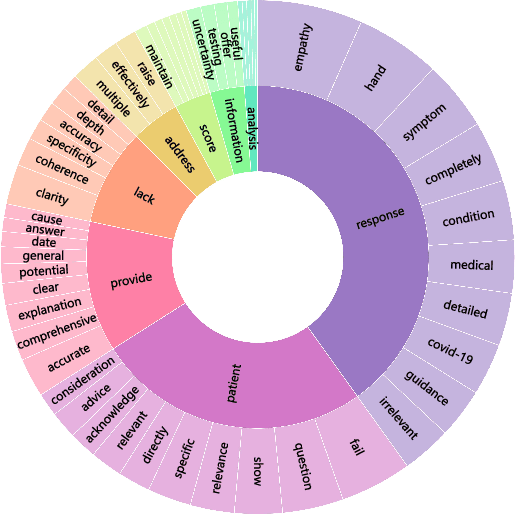
Abstract:As multimodal large language models (MLLMs) gain prominence in the medical field, the need for precise evaluation methods to assess their effectiveness has become critical. While benchmarks provide a reliable means to evaluate the capabilities of MLLMs, traditional metrics like ROUGE and BLEU employed for open domain evaluation only focus on token overlap and may not align with human judgment. Although human evaluation is more reliable, it is labor-intensive, costly, and not scalable. LLM-based evaluation methods have proven promising, but to date, there is still an urgent need for open-source multimodal LLM-based evaluators in the medical field. To address this issue, we introduce ACE-$M^3$, an open-sourced \textbf{A}utomatic \textbf{C}apability \textbf{E}valuator for \textbf{M}ultimodal \textbf{M}edical \textbf{M}odels specifically designed to assess the question answering abilities of medical MLLMs. It first utilizes a branch-merge architecture to provide both detailed analysis and a concise final score based on standard medical evaluation criteria. Subsequently, a reward token-based direct preference optimization (RTDPO) strategy is incorporated to save training time without compromising performance of our model. Extensive experiments have demonstrated the effectiveness of our ACE-$M^3$ model\footnote{\url{https://huggingface.co/collections/AIUSRTMP/ace-m3-67593297ff391b93e3e5d068}} in evaluating the capabilities of medical MLLMs.
I Don't Know: Explicit Modeling of Uncertainty with an [IDK] Token
Dec 09, 2024Abstract:Large Language Models are known to capture real-world knowledge, allowing them to excel in many downstream tasks. Despite recent advances, these models are still prone to what are commonly known as hallucinations, causing them to emit unwanted and factually incorrect text. In this work, we propose a novel calibration method that can be used to combat hallucinations. We add a special [IDK] ("I don't know") token to the model's vocabulary and introduce an objective function that shifts probability mass to the [IDK] token for incorrect predictions. This approach allows the model to express uncertainty in its output explicitly. We evaluate our proposed method across multiple model architectures and factual downstream tasks. We find that models trained with our method are able to express uncertainty in places where they would previously make mistakes while suffering only a small loss of encoded knowledge. We further perform extensive ablation studies of multiple variations of our approach and provide a detailed analysis of the precision-recall tradeoff of our method.
 Add to Chrome
Add to Chrome Add to Firefox
Add to Firefox Add to Edge
Add to Edge